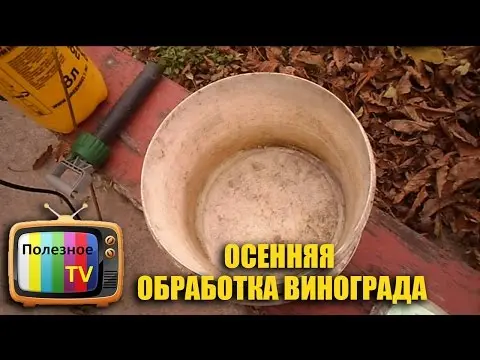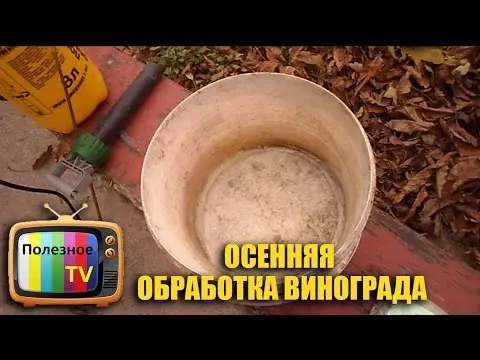Contents
A complete care for garden grapes is a whole series of procedures that you cannot do without if you want to harvest a generous harvest every year. And such care includes preparing the plant for wintering. This is the shelter of the vine with agrofiber or slate to protect it from impending frosts, and the processing of grapes in the fall from diseases.
The meaning and timing of the procedure
It would seem that mold, pests and various diseases do not bother plants in winter, so they do not need to be processed in autumn. In fact, such a procedure takes place, since infections and insects hibernate both in the ground of the near-trunk circle and under the bark of the shrub itself. Spores of diseases such as oidium, alternariosis, gray rot, in most cases hibernate on grape vines and cause serious harm to it. If you want the vineyard not to suffer from the invasion of pests and diseases with the advent of spring, process it from uninvited guests in the autumn.
It is important to understand what time is considered the most suitable for such a therapeutic or prophylactic procedure. Wait until you harvest, and then start treating shrubs. Spray the vines and leaves, because parasites, spores of diseases settle here. Keep in mind that processing is carried out in the evening. Otherwise, you risk seeing burns on the leaves.
Video “Autumn processing of grapes from diseases”
From this video you will learn how to properly process grapes from diseases in the autumn.
What to process
It is important to clearly understand the time frame for undertaking such work, than processing homemade grapes for the winter. In most cases, growers prefer copper or iron sulphate. If you suspect the presence of pests on the vine, buy ready-made chemicals. Folk remedies are also used, but it is important to know how to prepare them and how often to use them.
Copper sulfate

A substance such as copper sulfate has antifungal properties. Dilute it in advance and use clear dosages: dilute 50 g of the substance in a glass of water and pour into a 5-liter bucket, which is then filled to the top with water. Use vitriol to spray the vineyard immediately after diluting the product, otherwise it will lose its properties.
Try to process plants in calm weather, wind and precipitation are useless here. Make sure that rain is not expected in time, as it is important that moisture does not get on the leaves during the first four hours after spraying. If in the process you notice that the rhizome of the shrub has suffered from mold or pests, dig it up and place it in a fungicidal solution.
inkstone

Vine growers prefer to process their plantations with iron sulfate in the spring, after they remove the covering material from the vines. It is undesirable to use it in the fall, since such a substance contributes to the freezing of the root system, reducing the plant’s resistance to low temperatures.
Keep in mind that the grapes are sprayed generously: one bush will have up to 2 liters of the product diluted in water. It is important to take the process of preparing such a medicine seriously: strictly follow the instructions, do not forget to wear a protective suit and mask when working with iron sulphate.
Finished preparations

If pests or diseases threaten young grape varieties, start processing them soon after harvest. Pay attention to store-bought chemicals that are considered fast-acting.
Among the popular drugs are the following:
- Folpan, Sandofan, Delan, Amistar. They are used for spraying grapes in the event of mildew foci. It is important to remove branches that are affected by the disease, and process healthy-looking areas.
- “Impact”, “Mikal”, “Falcon”. The category of sulfur preparations is useful if the plant has suffered from oidium.
- “Horus”, “Rock”, “Rovral”. Such tools are indispensable for suspicion of gray rot.
From pests on grapes in the autumn, therapeutic compounds called “Rovikurt”, “Polyhom”, “Fundazol” help. When ticks appear on the vines, it is important to chasing and pinching. Most of these parasites affect the tops of the plant, so they are removed first. After harvesting, carefully inspect the vineyard: if the branches and leaves look unhealthy, use ready-made chemicals – Ridomil and Aktara.
Folk remedies

Processing grapes in the fall from diseases and pests is carried out not only with the help of ready-made store preparations, but also with the use of folk methods. If the plant is struck by oidium, follow these recommendations:
- Mow fresh grass, put in a pile. When it turns gray, covered with mold, transfer to a bucket, fill with water, mix thoroughly.
- Strain the prepared solution and treat the plants with it.
- If necessary, repeat the procedure as a preventive measure.
A solution of ash and laundry soap will relieve mildew, grapes are treated with iodine from gray rot.
General processing rules
Whatever means for spraying grapes you prefer, it is important to acquire a tool. Use a device with a nozzle and a sealed pump. Remember that the drugs have a potent effect, so they are diluted carefully, adhering to the dosages. Follow the instructions, and the plants will not suffer from a high concentration of the product.
It is important to adhere to the frequency of spraying. After the first stage of processing the grapes, take a break for a week. After that, treat the plant again to fix the result. Be especially careful when handling ready-made chemicals: wear a protective suit or at least gloves and a mask.
Take care of your vine bushes, treat them in the fall after harvest, choose a good shelter for them for the winter, and get plants that are resistant to low temperatures, diseases, and pests.









